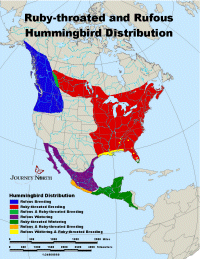| update |
| Humingbird Banding Collecting data for research and management |
|
Bird banding is one of the most important tools in ornithological research. Individual identification of birds makes possible studies of dispersal and migration, behavior and social structure, life-span and survival rate, and population growth. People have been banding birds for centuries. The first records of bird banding in North America are those of John James Audubon in the early 1800's. When banded birds are re-captured in a new location, we gain information about their movements. This data gives researchers information about migration patterns and to study individuals that have strayed from the normal migration pattern. After a bird is banded and released, their data is filed and stored with the Bird Banding Laboratory (BBL), a part of the USGS, or with the Canadian Wildlife Service. Later, if someone captures the same bird, the band number and information is reported. All bird banders receive special training and go through certification processes. Learn more: BBL Web site. |
|
 A Look at Hummingbird Banding |
|
